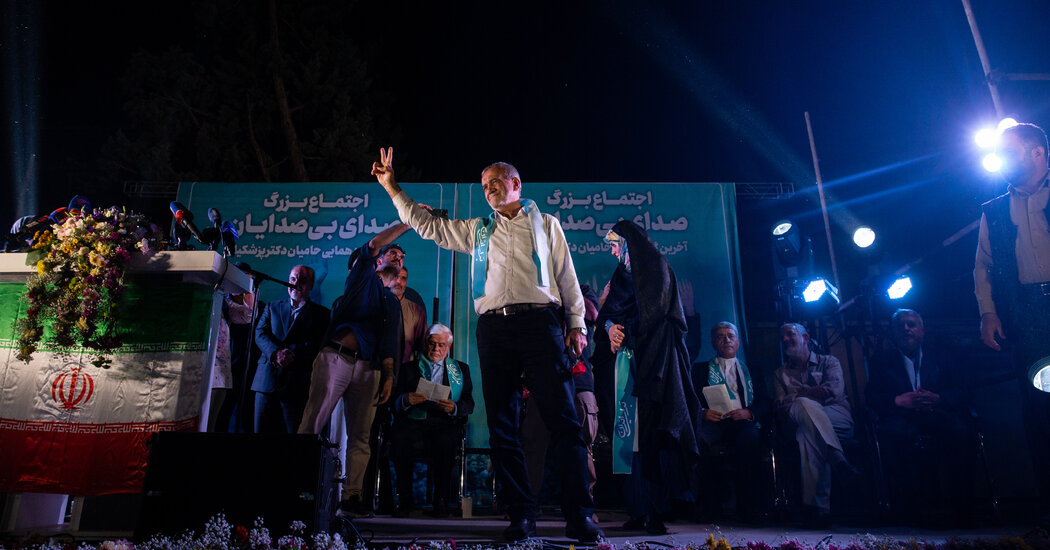The victory of reformist candidate Masoud Pezeshkian in Iran’s presidential runoff signals a shift from the government of Ebrahim Raisi, a conservative Shiite Muslim cleric and the preceding president who was killed in a helicopter crash in May.
Mr. Pezeshkian, a 69-year-old cardiac surgeon who served as a lawmaker in previous reformist governments and as health minister, beat the hard-line conservative candidate Saeed Jalili in Friday’s runoff, the government announced on Saturday.
Here are the most important takeaways from the election.
A stark choice spurred higher voter turnout
The runoff presented a political choice stark enough to galvanize Iranians who had boycotted the first round of elections. Turnout in the first round was about 40 percent, continuing a downward trend seen in recent parliamentary elections. Faced with candidates who represented radically different visions for Iran’s future, many voters who had stayed away from the polls during the first round decided to cast their ballots in the runoff.
When voting closed on Friday, turnout had increased by nearly 10 percentage points, to 49.8 percent, according to state media. Mr. Pezeshkian’s campaign slogan, “save Iran,” seems to have resonated with those who wanted change, albeit incremental change in a restricted political and social environment.
Iran’s government also led a public campaign to spur voters.
While the supreme leader, Ayatollah Ali Khamenei, maintains ultimate control of Iran, elections provide a veneer of legitimacy for the country’s authoritarian theocracy.
A return to the reformist agenda
Mr. Pezeshkian’s win marks a return of the relatively moderate reformist agenda in Iran after years of being sidelined.
He opposed the mandatory hijab law for women, promised to disband Iran’s morality police and to lift restrictions on the internet. He said he wants peaceful relations with the West.
But as he sought to persuade Iranians to vote for him, Mr. Pezeshkian, who served 16 years in Parliament and four years as health minister, had to contend with the disillusionment of voters who experienced little change under two previous presidents who had promised some.
Mohammad Khatami, a reformist, and Hassan Rouhani, a moderate centrist, won landslide victories in their elections, but in government, they were restricted by the ultimate power of Mr. Khamenei.
Will anything change inside Iran?
Mr. Pezeshkian has said he wants to bridge the divide between conservative and moderate voters, and he will be able to set domestic policy agenda as well as influence the shape of foreign policy.
But the country remains a theocracy led by an appointed cleric, Mr. Khamenei, who makes the final decisions on most important matters of state.
The president can, however, shift the tone in the country, analysts said. Mr. Pezeshkian is expected to tilt Iran away from the hard-line policies such as the mandatory hijab, which led to widespread discontent, an uprising and harsh crackdowns by the authorities under Mr. Raisi’s administration.
He is also expected to negotiate with the United States to resolve the standoff over the nuclear program and to try to lift the associated sanctions.
Mr. Pezeshkian’s candidacy was backed by a team of seasoned technocrats, and his cabinet is likely to reflect this. He has pledged to work with his rivals to solve some of Iran’s more intractable problems, including an economy debilitated by many years of the harsh international sanctions.
In 2018, former President Donald J. Trump unilaterally exited a nuclear deal between Iran and the West, even though international inspectors said Iran was complying with the terms.
One of his primary tasks will be to tackle inflation, which has sent the prices of fresh fruit, vegetables and meat up sharply.
But to revive the economy, Mr. Pezeshkian will have to work to reach a deal with the United States to lift the sanctions on its oil revenues and banking transactions. Despite U.S. efforts, Iran is not isolated internationally and has forged close ties with Russia, China and India. But the sanctions do impede its economic growth and trade.
Could Iran improve relations with the West?
Framing foreign policy as an economic issue, Mr. Pezeshkian has said he is willing to negotiate with Western powers, namely the United States, to remove the sanctions on Iran. He has also expressed a willingness to resume nuclear negotiations — which are interlocked with the sanctions — and to generally defuse tensions.
“Whoever ends its relations with the world will be held back. Why should we be fighting with the whole world?” Mr. Pezeshkian told Iranian media during the election campaign.
This is in stark contrast to his rival, Mr. Jalili, a former nuclear negotiator who opposed Iran’s 2015 nuclear deal with international powers for making too many concessions. During his presidential campaign, he also rejected any accommodation with the West, and instead sought to build stronger ties with Russia and China.
Under Mr. Raisi, the prior president, Iran continued to develop its missile arsenal, and its nuclear program kept advancing, reaching the status of a nuclear threshold state, with a breakout time of a week to build a simple nuclear bomb, experts say. The country also become an increasingly powerful but unpredictable player in the Middle East crisis.
Iran funds, arms and trains a network of military groups in the Middle East, including Hamas and Islamic Jihad in Gaza, Hezbollah in Lebanon, and the Houthis in Yemen, as well as militant groups in Iraq and Syria. The network, known in the region as the “axis of resistance,” has helped advance Iran’s strategic interests, both by growing its influence and serving as a forward defense.
When it comes to Iran’s animosity toward Israel, that is a matter of state policy set at the highest levels, from which the incoming president is unlikely to diverge.
